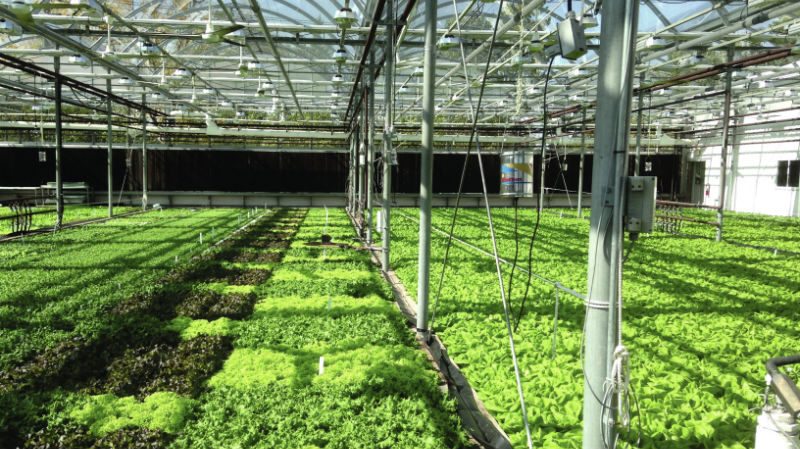
Growing Hydroponic Leafy Greens
Leafy greens such as lettuce, arugula, kale, mustard and spinach are among the most popular locally grown vegetables. They can be produced locally year-round in controlled environment greenhouses in hydroponics. This article will cover some of the basics of hydroponic systems and production methods for these crops.
Choose Your System
The two most common hydroponic growing systems for leafy greens are deep water culture (DWC) and nutrient film technique (NFT). In DWC, also referred to as raft or pond culture, seedlings are transplanted into Styrofoam rafts which are floated on a 6- to 12-inch constructed pond containing a large volume of nutrient solution (Figure 1, photo above). A pump is used to circulate water through the pond and an air pump or injection with oxygen is used to keep the pond aerated.
In NFT, seedlings are transplanted onto shallow channels where a thin film of nutrient solution is continuously circulated (Figure 2). The channels are sloped at 1 to 4 percent away from a center aisle and drained at the ends back to the water reservoir. An advantage of the DWC system is because a large volume of water is used rapid changes are avoided in water temperature, pH, electrical conductivity (EC) and nutrient solution composition.
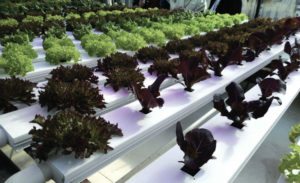
Head Lettuce
The Cornell University Controlled Environment Agriculture (CEA) group has a long history of research to optimize production of hydroponic lettuce. When proper growing conditions are maintained a 5- to 6-ounce head of lettuce can be produced from seed in 35 days. Seeds are surface sown into trays with 1-inch cells of rockwool, oasis or other substrate (Figure 3).
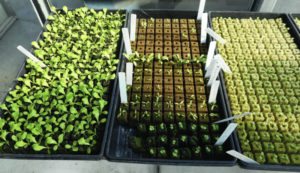
During germination (first 24 hours) the temperature is kept at 68° F with a minimum instantaneous light intensity no less than 50 μmol·m-2·s-1 or a daily light integral (DLI) of 4 mol·m-2·d-1. This level of irradiance prevents stretching of the seedlings while minimizing the tendency of supplemental lighting to dry out the surface of the medium.
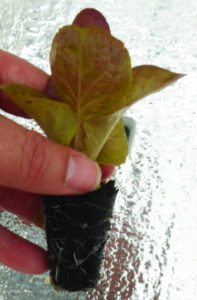
During the seedling stage (days 1 to 11+) greenhouse day/night temperatures are maintained at 75/66° F. A high DLI (22 mol·m- 2·d-1) is maintained using a combination of sunlight and supplemental light to push growth of seedlings. The DLI target can be met by lighting to 250 μmol·m-2·s-1 with a 24-hour photoperiod or 375 μmol·m-2·s-1 for a 16-hour photoperiod. Seedlings are ready to transplant into the hydroponic system when they have three to four true leaves (Figure 4). We have found this is at about day 11 when the temperature and light conditions are optimal (as described above). If half the DLI is used, seedlings will take twice as long (22 days) from seeding to transplant stage. Beginning at day 0 seedlings should be fertilized at each irrigation cycle at 100- to 150-ppm nitrogen using a complete fertilizer (see below).
The seedlings are then transplanted into the DWC or NFT system. During the growing on stage temperatures are maintained at 75/66° F day/night temperature with a relative humidity of 50 to 70 percent. The dissolved oxygen (DO) concentration of the nutrient solution should be about 7 to 8 ppm. We have found crop failure when DO is less than 3 ppm. Optimal light is critical to shorten crop cycles and maximize the number of crop turns per year. When DLI is maintained at 17 mol·m-2·d-1, 5- to 6-ounce heads are ready to harvest 24 days after transplanting. Lettuce can be respaced part way through the growing on stage to maximize space use efficiency. In DWC we initially transplant to foam boards with a spacing of 9 plants per square foot. At day 21, plants are respaced to their final spacing of 3.5 plants per square foot.
Growth of lettuce is directly proportional to the amount of light received, so if DLI is half of optimal (8.5 mol·m-2·d-1) plants will take twice as long (48 days) to finish. For head lettuce varieties, growth cannot be pushed too quickly with DLI, otherwise tipburn, a physiological disorder resulting from inadequate calcium supply to the growing point can occur. Symptoms of tipburn are necrotic (brown) spots on the edges of young leaves in the center of the head.

To help avoid tipburn, we highly recommend vertical airflow (paddle) fans which direct air downward over the developing lettuce heads. With proper airflow a DLI target of 17 mol·m-2·d-1 can be used, without proper airflow a lower DLI target such as 13 to 14 mol·m-2·d-1 is needed with its correspondingly longer crop cycle. Use of shade compound or ideally a retractable shade curtain is necessary when growing lettuce during the high light months due to the issue with tipburn at high DLI. Lettuce responds well to carbon dioxide enrichment to increase photosynthesis rates and this can be used to achieve similar plant growth with lower DLIs.
Regarding fertilizer, we have successfully used for many years Sonneveld’s hydroponic lettuce recipe supplied at 150-ppm nitrogen (Table 1). The nutrient solution is maintained at a pH of 5.5 to 6.0 to maximize nutrient availability to the plant. The fertilizer electrical conductivity (EC) is about 1.5 mhos/cm2.
The above method for growing head lettuce can be similarly used for grow growing kale, swiss chard, pak choi or bunches of herbs.
Baby Leaf Greens
Many crops lend themselves well to hydroponic baby leaf production including: lettuce, arugula, upland cress, kale, mizuna and mustard. One method for producing baby leafy greens is to adapt the head lettuce production system described above by sowing multiple seeds per cell (for example, six to 12 depending on crop) and then transplanting to the high density spacing (nine cells per square foot).

An alternative production method in DWC is to use foam Speedling trays (Figure 5). The Speedling trays are 13 inches wide by 26 inches long and 1.75 inches deep and contain 336 cells. Other types of multi-cell foam trays can be used and care could be taken to select cell configurations which reduce the volume of potting mix needed. The cells are filled with a soilless potting mix such as commercial peat/perlite or coir substrate. One seed per cell is sown. Plants are germinated for about three days and then floated on the pond for about 10 to 14 days (Figure 6). We have not experimentally researched optimum light and temperature but have found good performance with a DLI of 17 mol·m-2·d-1 and day/night temperatures of 75/66° F.

For example, in recent trials the saleable fresh weight of arugula ‘Astro’, kale ‘Red Russian’ and lettuce ‘Outredgeous’ was 12, 14 and 15 ounces per square foot, respectively, when germinated for three days and floated for 10 days in DWC prior to harvesting. Baby leaf spinach can also be grown hydroponically however we have found it to be much more susceptible to Pythium root rot than other crops.








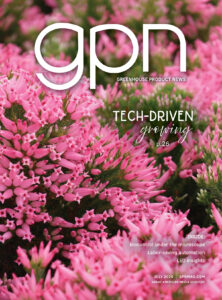
 Video Library
Video Library 


















